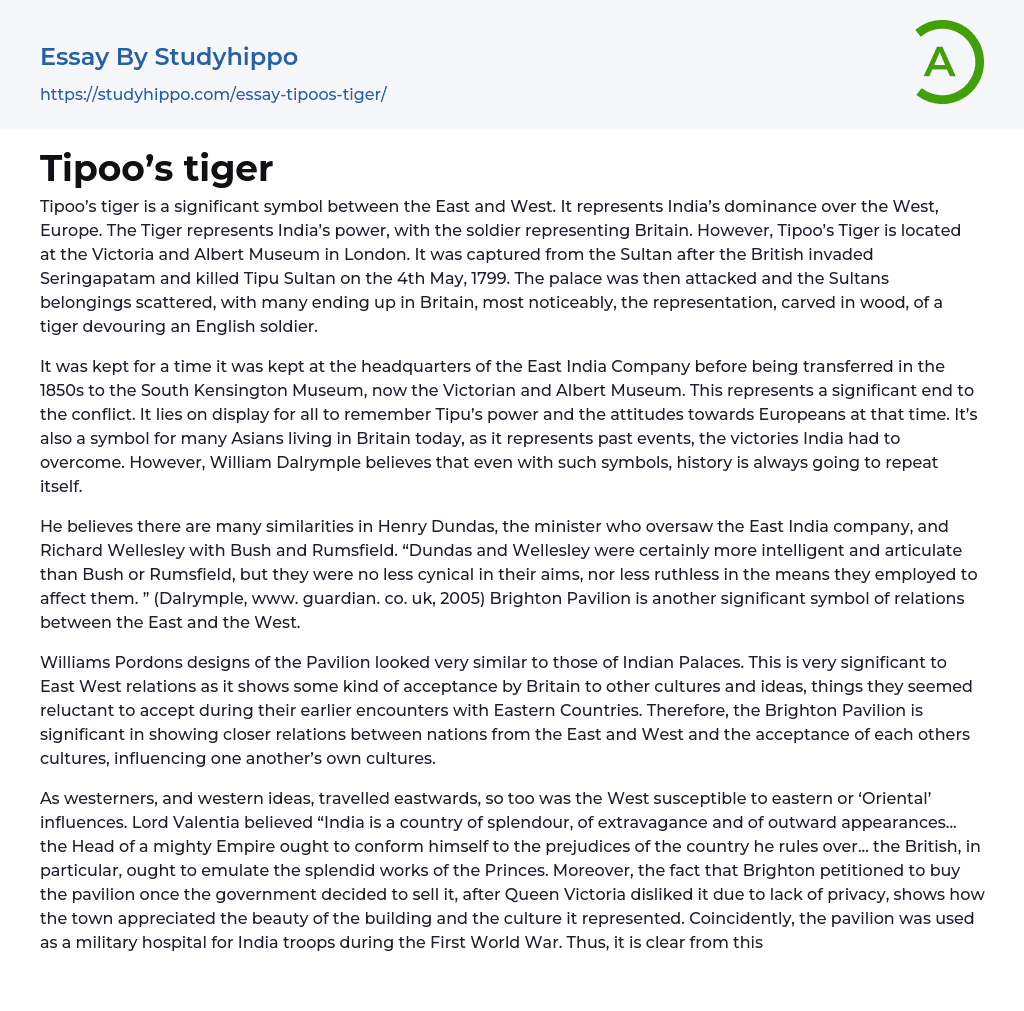Tipoo's Tiger is symbolic of the clash between the East and West, with India being representative of the East and Europe embodying the West. The tiger serves as an icon for Indian strength, portrayed devouring a British soldier. Despite its historical roots in India, this relic currently resides in London at the Victoria and Albert Museum instead of its birthplace. Post-British invasion of Seringapatam leading to Tipu Sultan's death on May 4th, 1799, several artifacts were relocated resulting from ensuing turmoil due to his downfall and devastation of his palace. Among these moved artefacts was a captivating wooden sculpture showing a tiger attacking an English soldier which later found its way into Britain.
Initially situated in the East India Company's main office, it was later transferred to what we know today as the Victoria and Albert Museum in South Kensington around
...the 1850s. This move signified an important resolution to a long-standing argument. It is still displayed as a portrayal of Tipu's reign and his perspective on Europeans during that era. Many Asians living in Britain today see it as an emblem of historical events and previous victories of India. Nevertheless, William Dalrymple suggests that history often repeats itself irrespective of these symbols.
He draws comparisons between Henry Dundas, who was in charge of the East India company, Richard Wellesley, as well as Bush and Rumsfield. "Dundas and Wellesley assuredly possessed higher intelligence and articulation levels than Bush or Rumsfield, but their measures and objectives were equivocally ruthless and cynical." (Dalrymple, www. guardian. co. uk, 2005) Furthermore, Brighton Pavilion stands as another key representation of East-West relations.
The design resemblances
between Williams Pordons' Pavilion and Indian Palaces are noteworthy, signaling a display of British receptivity towards diverse cultures and philosophies, something they were hesitant to acknowledge in their initial interactions with Eastern Nations. Thus, Brighton Pavilion serves as a symbol of bridgework between Eastern and Western nations, demonstrating mutual cultural acceptance and reciprocal cultural influence.
As notions from the west journeyed east, so too did the western world become receptive to eastern or 'Oriental' influences. Lord Valentia held the outlook that "India is a land of grandeur, opulence, and impressions... The sovereign of a powerful empire should adapt to the biases of the territory he presides over... Specifically, the British should strive to match the magnificent creations of the Princes. Furthermore, Brighton's endeavor to purchase the pavilion, after Queen Victoria expressed her distaste for it due to privacy concerns when the government decided to put it up for sale, demonstrates how the locality cherished both the architectural attractiveness of the building and the culture it signified. Interestingly enough, during World War I, the pavilion served as a military infirmary for Indian soldiers. As such, it's evident that the pavilion serves as an emblem of cessation of hostilities between East and Western nations and a mutual acceptance of each other's cultures.
- Victorian Era essays
- Henry v essays
- Stonehenge essays
- 1920S essays
- 1950S essays
- 1960S essays
- 19Th Century essays
- 20Th Century essays
- Ancient Greece essays
- Bravery essays
- British Empire essays
- Civilization essays
- Colonialism essays
- Declaration of Independence essays
- Evidence essays
- Genocide essays
- Gilded Age essays
- Historical Figures essays
- Historiography essays
- History of the United States essays
- Letter from Birmingham Jail essays
- Louisiana Purchase essays
- Nazi Germany essays
- Rebellion essays
- Revolution essays
- Roman Empire essays
- Russian Empire essays
- The Columbian Exchange essays
- Vikings essays
- War essays
- What is History essays
- World History essays
- World Hunger essays
- Bangladesh essays
- China essays
- Hong Kong essays
- India essays
- Japan essays
- Kuala Lumpur essays
- Malaysia essays
- Manila essays
- Pakistan essays
- Philippines essays
- Singapore essays
- Vietnam essays
- Vietnamese essays
- Agriculture essays
- Albert einstein essays
- Animals essays
- Archaeology essays




